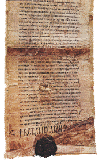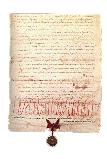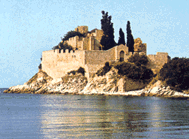 The Chilandar
Monastery was first mentioned in a Greek manuscript of
1015, as "completely abandoned and empty". It
is believed that a Boatman - George Chelandarios was the
founder of this monastery in 980, and the Monastery was
called after him. In the first Serbian sources it took
fonn as Hilandar. The Chilandar
Monastery was first mentioned in a Greek manuscript of
1015, as "completely abandoned and empty". It
is believed that a Boatman - George Chelandarios was the
founder of this monastery in 980, and the Monastery was
called after him. In the first Serbian sources it took
fonn as Hilandar.
 As it is known, the Chilandar
Monastery was granted by Emperor Alexius III, to Serbian
monk Sava and to his father the Grand Zhupan of Serbia
Stevan Nemanja, in 1198, - 800 years ago. It happeened
when Stevan Nemanja renaunced the throne and came as a
monk of the Studenica Monastery in Serbia, to his
youngest son, monk Sava, in Greek monastery of Vatopedi,
on Holy Athos. Simeon and Sava renewed the Chilandar
monastery. As it is known, the Chilandar
Monastery was granted by Emperor Alexius III, to Serbian
monk Sava and to his father the Grand Zhupan of Serbia
Stevan Nemanja, in 1198, - 800 years ago. It happeened
when Stevan Nemanja renaunced the throne and came as a
monk of the Studenica Monastery in Serbia, to his
youngest son, monk Sava, in Greek monastery of Vatopedi,
on Holy Athos. Simeon and Sava renewed the Chilandar
monastery. Since Chilandar monastery was free of
both the Protaton and imperial authority from
Constantinople, Simeon Nemanja issued a gold-sealed
charter to Chilandar constituting it as a Serbian
monastery and the hereditary foundation of the Nemanjic
family, granting to the Monastery needed property for its
needs since it becames completely selfgoverning Serbian
monastery. The first abbot of Chilandar was Methodius,
appointed by St. Simeon himself. At the begining there
were about 10 to 15 Serbian monks. After six years in
Chilandar monastery were some ninety monks, following St.
Sava's typikon. Monk Simeon died on February 13, 1199, in
the narthex of Chilandar monastery and was buried in the
monastery church. In 1206, St. Sava transferred the
relics of St. Simeon to Studenica Monastery in Serbia. Since Chilandar monastery was free of
both the Protaton and imperial authority from
Constantinople, Simeon Nemanja issued a gold-sealed
charter to Chilandar constituting it as a Serbian
monastery and the hereditary foundation of the Nemanjic
family, granting to the Monastery needed property for its
needs since it becames completely selfgoverning Serbian
monastery. The first abbot of Chilandar was Methodius,
appointed by St. Simeon himself. At the begining there
were about 10 to 15 Serbian monks. After six years in
Chilandar monastery were some ninety monks, following St.
Sava's typikon. Monk Simeon died on February 13, 1199, in
the narthex of Chilandar monastery and was buried in the
monastery church. In 1206, St. Sava transferred the
relics of St. Simeon to Studenica Monastery in Serbia.
The most
important position in the Monastery was the abbot. The
oikonomos was the most important position after abbot,
with two assistants - paroikonomos and oikonomos. The
most remarcable known abbots of Chilandar monastery in
13th century and at the begining of 14th century were,
after Methodius, Joanikije, who became Serbian archbishop
in 1272.; Jevstatije (1262-1265), later bishop of Zeta
and then archbishop of Serbia (1279-1286; Stephan,
Kirijak, Arsenije, Sava.
 In the
Monastery there had been open a chamber with beds for
seriously sick monks, which is counted as the first
Serbian hospital. It was later expanded by tzar Dushan
and tzar Lazar, following the latest West Europian
methods, on the basis of classical traditions of
Hippocrates, Galen, Dioscorides, etc. (see manucripts
with medical texts from the late 14th and mid 16th
centuries in Chilandar). By the mid 14th century,
Chilandar monastery possesed almost a fifth of the Holy
Athos peninsula alone (about 40 square miles). After the
Byzantine emperors John Ducas Vatatzes and In the
Monastery there had been open a chamber with beds for
seriously sick monks, which is counted as the first
Serbian hospital. It was later expanded by tzar Dushan
and tzar Lazar, following the latest West Europian
methods, on the basis of classical traditions of
Hippocrates, Galen, Dioscorides, etc. (see manucripts
with medical texts from the late 14th and mid 16th
centuries in Chilandar). By the mid 14th century,
Chilandar monastery possesed almost a fifth of the Holy
Athos peninsula alone (about 40 square miles). After the
Byzantine emperors John Ducas Vatatzes and  Michael VIII Palaealogus, and the Serbian
kings Vladislav, Urosh I and Dragutin, - the most
important benefactor of Chilandar monastery was Serbian
king Milutin (1282-1321), exposing Serbia to stronger
Byzantine social and cultural influence by incursions
into Byzantine territory in Macedonia. Michael VIII Palaealogus, and the Serbian
kings Vladislav, Urosh I and Dragutin, - the most
important benefactor of Chilandar monastery was Serbian
king Milutin (1282-1321), exposing Serbia to stronger
Byzantine social and cultural influence by incursions
into Byzantine territory in Macedonia.  He in 1293, built a new main
church on the foundations of the old one, extending
existing fortifications; in 1302 he built Hrusija by the
harbour and so-called Milutin's Tower. At the end of the
14th century and in early 15th century, during Serbian
princes and despots, the Chilandar's property continued
to expand. He in 1293, built a new main
church on the foundations of the old one, extending
existing fortifications; in 1302 he built Hrusija by the
harbour and so-called Milutin's Tower. At the end of the
14th century and in early 15th century, during Serbian
princes and despots, the Chilandar's property continued
to expand.
Prince
Lazar (1371-1389) added to the main Chilandar church
so-called Lazar's narthex. It was before the Battle of
Kosovo.
 St. Sava had spent eleven years as
archmandrite of the Studenica monastery in Serbia
(1206-1217), and then again returned to Holy Athos, and
set about gaining an independent, autocephalous
archbishopric for Serbia, which he did achieved in Nicaea
in 1219, and became the first Serbian archbishop. Coming
back from Nicaea to Serbia, he took from Chilandar the
Krmchija-Code and other needed books in order to build
the new Church and state organization. He also took from
Chilandar some monks, and appointed them bishops for
diaceses which he had founded. The Serbian Church and
Serbian State were very well established. St. Sava had spent eleven years as
archmandrite of the Studenica monastery in Serbia
(1206-1217), and then again returned to Holy Athos, and
set about gaining an independent, autocephalous
archbishopric for Serbia, which he did achieved in Nicaea
in 1219, and became the first Serbian archbishop. Coming
back from Nicaea to Serbia, he took from Chilandar the
Krmchija-Code and other needed books in order to build
the new Church and state organization. He also took from
Chilandar some monks, and appointed them bishops for
diaceses which he had founded. The Serbian Church and
Serbian State were very well established.
|
 The Chilandar
Monastery was first mentioned in a Greek manuscript of
1015, as "completely abandoned and empty". It
is believed that a Boatman - George Chelandarios was the
founder of this monastery in 980, and the Monastery was
called after him. In the first Serbian sources it took
fonn as Hilandar.
The Chilandar
Monastery was first mentioned in a Greek manuscript of
1015, as "completely abandoned and empty". It
is believed that a Boatman - George Chelandarios was the
founder of this monastery in 980, and the Monastery was
called after him. In the first Serbian sources it took
fonn as Hilandar. As it is known, the Chilandar
Monastery was granted by Emperor Alexius III, to Serbian
monk Sava and to his father the Grand Zhupan of Serbia
Stevan Nemanja, in 1198, - 800 years ago. It happeened
when Stevan Nemanja renaunced the throne and came as a
monk of the Studenica Monastery in Serbia, to his
youngest son, monk Sava, in Greek monastery of Vatopedi,
on Holy Athos. Simeon and Sava renewed the Chilandar
monastery.
As it is known, the Chilandar
Monastery was granted by Emperor Alexius III, to Serbian
monk Sava and to his father the Grand Zhupan of Serbia
Stevan Nemanja, in 1198, - 800 years ago. It happeened
when Stevan Nemanja renaunced the throne and came as a
monk of the Studenica Monastery in Serbia, to his
youngest son, monk Sava, in Greek monastery of Vatopedi,
on Holy Athos. Simeon and Sava renewed the Chilandar
monastery. Since Chilandar monastery was free of
both the Protaton and imperial authority from
Constantinople, Simeon Nemanja issued a gold-sealed
charter to Chilandar constituting it as a Serbian
monastery and the hereditary foundation of the Nemanjic
family, granting to the Monastery needed property for its
needs since it becames completely selfgoverning Serbian
monastery. The first abbot of Chilandar was Methodius,
appointed by St. Simeon himself. At the begining there
were about 10 to 15 Serbian monks. After six years in
Chilandar monastery were some ninety monks, following St.
Sava's typikon. Monk Simeon died on February 13, 1199, in
the narthex of Chilandar monastery and was buried in the
monastery church. In 1206, St. Sava transferred the
relics of St. Simeon to Studenica Monastery in Serbia.
Since Chilandar monastery was free of
both the Protaton and imperial authority from
Constantinople, Simeon Nemanja issued a gold-sealed
charter to Chilandar constituting it as a Serbian
monastery and the hereditary foundation of the Nemanjic
family, granting to the Monastery needed property for its
needs since it becames completely selfgoverning Serbian
monastery. The first abbot of Chilandar was Methodius,
appointed by St. Simeon himself. At the begining there
were about 10 to 15 Serbian monks. After six years in
Chilandar monastery were some ninety monks, following St.
Sava's typikon. Monk Simeon died on February 13, 1199, in
the narthex of Chilandar monastery and was buried in the
monastery church. In 1206, St. Sava transferred the
relics of St. Simeon to Studenica Monastery in Serbia. In the
Monastery there had been open a chamber with beds for
seriously sick monks, which is counted as the first
Serbian hospital. It was later expanded by tzar Dushan
and tzar Lazar, following the latest West Europian
methods, on the basis of classical traditions of
Hippocrates, Galen, Dioscorides, etc. (see manucripts
with medical texts from the late 14th and mid 16th
centuries in Chilandar). By the mid 14th century,
Chilandar monastery possesed almost a fifth of the Holy
Athos peninsula alone (about 40 square miles). After the
Byzantine emperors John Ducas Vatatzes and
In the
Monastery there had been open a chamber with beds for
seriously sick monks, which is counted as the first
Serbian hospital. It was later expanded by tzar Dushan
and tzar Lazar, following the latest West Europian
methods, on the basis of classical traditions of
Hippocrates, Galen, Dioscorides, etc. (see manucripts
with medical texts from the late 14th and mid 16th
centuries in Chilandar). By the mid 14th century,
Chilandar monastery possesed almost a fifth of the Holy
Athos peninsula alone (about 40 square miles). After the
Byzantine emperors John Ducas Vatatzes and  Michael VIII Palaealogus, and the Serbian
kings Vladislav, Urosh I and Dragutin, - the most
important benefactor of Chilandar monastery was Serbian
king Milutin (1282-1321), exposing Serbia to stronger
Byzantine social and cultural influence by incursions
into Byzantine territory in Macedonia.
Michael VIII Palaealogus, and the Serbian
kings Vladislav, Urosh I and Dragutin, - the most
important benefactor of Chilandar monastery was Serbian
king Milutin (1282-1321), exposing Serbia to stronger
Byzantine social and cultural influence by incursions
into Byzantine territory in Macedonia.  He in 1293, built a new main
church on the foundations of the old one, extending
existing fortifications; in 1302 he built Hrusija by the
harbour and so-called Milutin's Tower. At the end of the
14th century and in early 15th century, during Serbian
princes and despots, the Chilandar's property continued
to expand.
He in 1293, built a new main
church on the foundations of the old one, extending
existing fortifications; in 1302 he built Hrusija by the
harbour and so-called Milutin's Tower. At the end of the
14th century and in early 15th century, during Serbian
princes and despots, the Chilandar's property continued
to expand. St. Sava had spent eleven years as
archmandrite of the Studenica monastery in Serbia
(1206-1217), and then again returned to Holy Athos, and
set about gaining an independent, autocephalous
archbishopric for Serbia, which he did achieved in Nicaea
in 1219, and became the first Serbian archbishop. Coming
back from Nicaea to Serbia, he took from Chilandar the
Krmchija-Code and other needed books in order to build
the new Church and state organization. He also took from
Chilandar some monks, and appointed them bishops for
diaceses which he had founded. The Serbian Church and
Serbian State were very well established.
St. Sava had spent eleven years as
archmandrite of the Studenica monastery in Serbia
(1206-1217), and then again returned to Holy Athos, and
set about gaining an independent, autocephalous
archbishopric for Serbia, which he did achieved in Nicaea
in 1219, and became the first Serbian archbishop. Coming
back from Nicaea to Serbia, he took from Chilandar the
Krmchija-Code and other needed books in order to build
the new Church and state organization. He also took from
Chilandar some monks, and appointed them bishops for
diaceses which he had founded. The Serbian Church and
Serbian State were very well established.